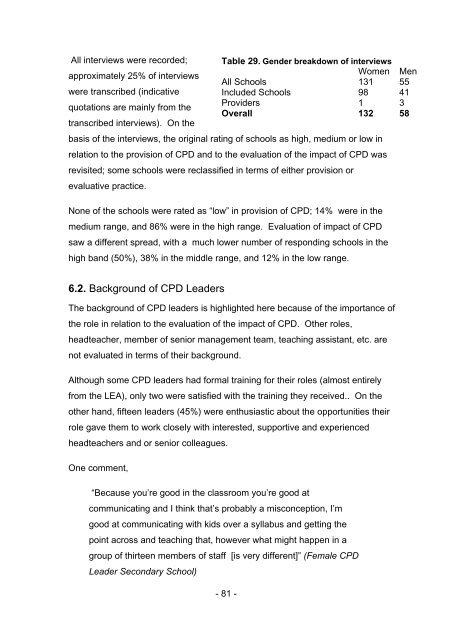Evaluating the Impact of Continuing Professional Development (CPD)
Evaluating the Impact of Continuing Professional Development (CPD)
Evaluating the Impact of Continuing Professional Development (CPD)
You also want an ePaper? Increase the reach of your titles
YUMPU automatically turns print PDFs into web optimized ePapers that Google loves.
All interviews were recorded; Table 29. Gender breakdown <strong>of</strong> interviews<br />
approximately 25% <strong>of</strong> interviews<br />
Women Men<br />
All Schools 131 55<br />
were transcribed (indicative Included Schools 98 41<br />
quotations are mainly from <strong>the</strong><br />
Providers 1 3<br />
Overall 132 58<br />
transcribed interviews). On <strong>the</strong><br />
basis <strong>of</strong> <strong>the</strong> interviews, <strong>the</strong> original rating <strong>of</strong> schools as high, medium or low in<br />
relation to <strong>the</strong> provision <strong>of</strong> <strong>CPD</strong> and to <strong>the</strong> evaluation <strong>of</strong> <strong>the</strong> impact <strong>of</strong> <strong>CPD</strong> was<br />
revisited; some schools were reclassified in terms <strong>of</strong> ei<strong>the</strong>r provision or<br />
evaluative practice.<br />
None <strong>of</strong> <strong>the</strong> schools were rated as “low” in provision <strong>of</strong> <strong>CPD</strong>; 14% were in <strong>the</strong><br />
medium range, and 86% were in <strong>the</strong> high range. Evaluation <strong>of</strong> impact <strong>of</strong> <strong>CPD</strong><br />
saw a different spread, with a much lower number <strong>of</strong> responding schools in <strong>the</strong><br />
high band (50%), 38% in <strong>the</strong> middle range, and 12% in <strong>the</strong> low range.<br />
6.2. Background <strong>of</strong> <strong>CPD</strong> Leaders<br />
The background <strong>of</strong> <strong>CPD</strong> leaders is highlighted here because <strong>of</strong> <strong>the</strong> importance <strong>of</strong><br />
<strong>the</strong> role in relation to <strong>the</strong> evaluation <strong>of</strong> <strong>the</strong> impact <strong>of</strong> <strong>CPD</strong>. O<strong>the</strong>r roles,<br />
headteacher, member <strong>of</strong> senior management team, teaching assistant, etc. are<br />
not evaluated in terms <strong>of</strong> <strong>the</strong>ir background.<br />
Although some <strong>CPD</strong> leaders had formal training for <strong>the</strong>ir roles (almost entirely<br />
from <strong>the</strong> LEA), only two were satisfied with <strong>the</strong> training <strong>the</strong>y received.. On <strong>the</strong><br />
o<strong>the</strong>r hand, fifteen leaders (45%) were enthusiastic about <strong>the</strong> opportunities <strong>the</strong>ir<br />
role gave <strong>the</strong>m to work closely with interested, supportive and experienced<br />
headteachers and or senior colleagues.<br />
One comment,<br />
“Because you’re good in <strong>the</strong> classroom you’re good at<br />
communicating and I think that’s probably a misconception, I’m<br />
good at communicating with kids over a syllabus and getting <strong>the</strong><br />
point across and teaching that, however what might happen in a<br />
group <strong>of</strong> thirteen members <strong>of</strong> staff [is very different]” (Female <strong>CPD</strong><br />
Leader Secondary School)<br />
- 81 -

















